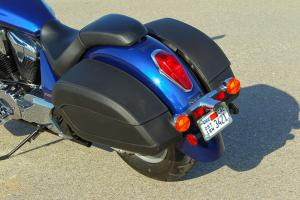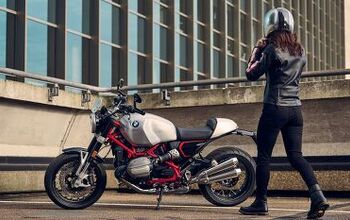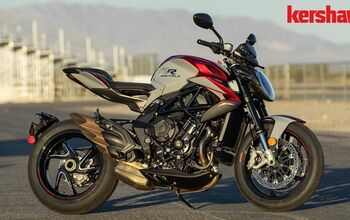2010 Honda VT1300 Stateline and VT1300 Interstate Review - Motorcycle.com
We recently reported on our time aboard Honda’s all-new mid-weight cruiser line, the VT1300 series, with our initial review focusing on the pro-street styled Sabre.
Although the Sabre has many things in common with its VT1300 brothers, the Stateline and Interstate differ enough from the Sabre to warrant a closer look.
As we learned in the Sabre review, all three models use identical engines: Honda’s 1312cc, fuel-injected, liquid-cooled, three-valve-per-cylinder, 52-degree Vee with single-pin crankshaft employed for that thumpity-thumpity-thump (or potato-potato-potato if you prefer) sound and engine feel so many cruiser fans enjoy.
In addition to the engine platform shared amongst the three metric cruisers, the key styling element of a long, flowing line stretching from headlight to taillight is evident when viewing the trio at a glance.
And although in profile the Stateline bears a strong resemblance to the Sabre, the ‘State models still manage to make their own mark.
The Stateline’s understated and unadorned appearance aims to achieve a classic/retro cruiser pose via valanced fenders (also on the Interstate) as opposed to the more sculpted fender work on the Sabre.
The Interstate makes the leap to touring cruiser with a windscreen, saddlebags, floorboards, heel/toe shifter and larger brake pedal as standard; chrome fork covers give it additional flare.
The ‘State models further separate from their pro-street-ish brother by way of a 17-inch front wheel (140/80-17) in contrast to the Sabre’s style-conscious 21-incher (90/90-21).
Additionally, V-Twin cylinder fins of the ‘States get the blacked-out treatment.
A wider, pullback handlebar is traded for the Sabre’s narrow drag-style ‘bar. For my tastes I prefer the wide handlebar on the Interstate and Stateline, not only for the more relaxed riding position but also for the increased steering leverage.
The Interstate’s shield is one of those ‘tween heights: tall enough to offer decent protection, but short enough to generate some turbulence. Still, some screen is better than none during longer rides. You’re likely to arrive fresher at your destination – saved from the fatigue of windblast – than if you didn’t have a shield.
Though the Interstate’s standard saddlebags are nicely integrated into the bike’s overall styling, I found the lid release button cumbersome to operate, as it’s hidden on the fender-side, forward portion of the bag. It took me a minute or four to locate them, and then a wee bit longer to efficiently work them. Otherwise, they provide a decent amount of stowage space for, say, a minimalist weekend on the road.
Aside from the ‘States’ wider profile front tire, and the Interstate’s touring accoutrements, the ‘States are functionally the same as the Sabre. However, front-end feel and general handling traits do differ.
The ‘States’ chubbier front tire provides a more forgiving ride up front, yet the tire’s tread blocks are thicker than those on the Sabre’s skinny front meat, so feel isn’t as precise, perhaps even a bit ponderous compared to the Sabre’s steering characteristics.
There’s a trade-off then: better feel/steering response on the Sabre, but a more comfortable ride quality on the ‘States. A sure indication of the different market segments Honda is after with the variety in the VT1300 line.
Over 40 Honda accessories are available for the VT1300 series; however, if you fancy trying to source the Interstate’s standard screen and saddlebags as fitment for the Stateline, forget it. Those exact pieces aren’t available, as Honda needs some way to differentiate the two bikes. But there are a number of stylized saddlebags and shorter screens available for both the Stateline and Sabre.
Now, in a bit of tit-for-tat, the Stateline has something the Interstate can’t have – at least not yet.
ABS is an available option for the Stateline (Sabre, too), pushing its MSRP of $11,699 by $1000. But in order to keep below the $13K threshold for these models, Honda withheld ABS from the Interstate that rings in with a $12,749 tag. That’s a bummer for a market segment that could benefit from ABS, a fact that Honda acknowledges.
But Big Red’s research also revealed that there’s something about that thirteen-thousand-dollar tipping point that is – for whatever reason – crucial to buyers’ decision-making process when it comes time to pull the pocketbook trigger.
Perhaps it’s a similar mental barrier like that $19.99 infomercial item appearing cheaper than an identical $20.00 item?
Consider the Interstate’s American competition, Harley-Davidson’s Road King, is over four grand more than the Honda, and it’s plausible that buyers not brand loyal could take a long second look at the Interstate despite a somewhat nominal 272cc deficit to the Road King.
On the metric end of the competition spectrum, the ‘States get stiffer resistance from Kawasaki in the form of the Vulcan 1700 Classic.
A direct match-up to the Stateline, the Vulcan Classic offers a larger (1700cc vs 1312cc) liquid-cooled, four-valve-per-cylinder, 52-degree Vee, which Kawi claims churns out 108 ft-lbs at the crankshaft. Additionally, a belt final-drive (versus shaft drive) is how the Vulcan puts its power to the rear wheel.
The Vulcan Classic retails for a paltry $300 over the Honda’s MSRP.
The Vulcan 1700 LT is the Interstate’s touring nemesis, but the Honda fairs a little better with a $1450 savings against the Vulcan LT.
The 2010 Honda VT1300 Stateline is available in colors Black or Candy Dark Red, with the ABS model in Candy Dark Red only. The Interstate comes in Black or Pearl Blue. Both models should be in dealers now.
Related Reading
2010 Honda VT1300 Sabre Review
2010 Kawasaki Vulcan 1700 Classic vs 2010 Triumph Thunderbird
2010 Honda Shadow RS Review
2010 Honda Shadow Phantom Review
All Cruiser Reviews on Motorcycle.com
All Things Honda on Motorcycle.com
More by Pete Brissette


































Comments
Join the conversation